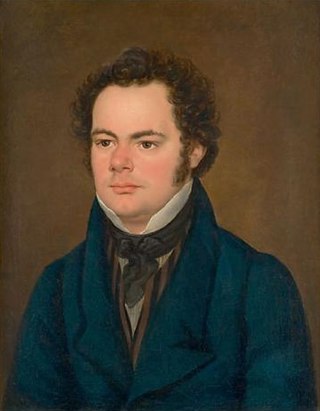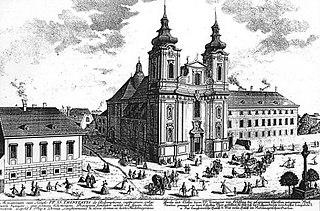Movements
- Weingartner completion [5]
- Newbould completion
- Adagio – Allegro
- Andante
- Scherzo: Allegro
- Allegro giusto
(The true marking is ffz rather than fz, but that is not available in LilyPond as implemented on Wikipedia.)
Symphony No. 7 is the name given to a four-movement symphony in E major (D 729) drafted by Franz Schubert in August 1821. Although the work (which comprises about 1350 bars) [1] is structurally complete, Schubert only orchestrated the slow introduction and the first 110 bars of the first movement. The rest of the work is continued on 14-stave score pages as a melodic line with occasional basses or counterpoints, giving clues as to changes in orchestral texture.
Schubert seems to have laid the symphony aside in order to work on his opera Alfonso und Estrella , and never returned to it. The manuscript was given by Schubert's brother Ferdinand to Felix Mendelssohn and was subsequently acquired by Sir George Grove, who bequeathed it to the Royal College of Music in London. There are at least four completions: by John Francis Barnett (1881), Felix Weingartner (1934), Brian Newbould (1980), and Richard Dünser (2022). [2] [3] [4] The work is now generally accepted to be Schubert's Seventh Symphony, [1] [2] [5] [6] an appellation which some scholars had preferred to leave for the chimerical 'Gastein Symphony' that was long believed to have been written and lost in 1824, and is now generally identified as the "Great C Major" symphony, No. 9.
The revised Deutsch catalogue and the Neue Schubert-Ausgabe do not number this symphony, preferring to give the number 7 to the Unfinished Symphony. [7] In the complete edition of Breitkopf & Härtel (Franz Schubert's Works), the number 7 is given to the Great C major symphony.
This symphony is scored for an even larger orchestral force than Schubert's eighth and ninth symphonies. The score calls for double woodwinds, four horns, two trumpets, three trombones, timpani and strings. [3]

(The true marking is ffz rather than fz, but that is not available in LilyPond as implemented on Wikipedia.)

The Symphony No. 9 in C major, D 944, known as The Great, is the final symphony completed by Franz Schubert. It was first published by Breitkopf & Härtel in 1849 as "Symphonie / C Dur / für großes Orchester" and listed as Symphony No. 8 in the New Schubert Edition. Originally called The Great C major to distinguish it from his Symphony No. 6, the Little C major, the subtitle is now usually taken as a reference to the symphony's majesty. Unusually long for a symphony of its time, a typical performance of The Great lasts an hour when all repeats indicated in the score are taken. The symphony was not professionally performed until a decade after Schubert's death.

Franz Schubert's Symphony No. 8 in B minor, D. 759, commonly known as the Unfinished Symphony, is a musical composition that Schubert started in 1822 but left with only two movements—though he lived for another six years. A scherzo, nearly completed in piano score but with only two pages orchestrated, also survives.

Franz Schubert wrote his Sonata in C major for piano four-hands, D 812, in June 1824 during his second stay at the Esterházy estate in Zseliz. The extended work, in four movements, has a performance time of around 40 to 45 minutes. It was published as Grand Duo, Op. 140, in 1837, nine years after the composer's death.

Schubert's Symphony No. 10 in D major, D 936A, is an unfinished work that survives in a piano sketch. Written during the last weeks of the composer's short life, it was only properly identified in the 1970s. It has been orchestrated by Brian Newbould in a completion that has subsequently been performed, published and recorded.
The Symphony No. 4 in C minor, D 417, is a symphony by Franz Schubert completed in April 1816 when Schubert was 19 years old, a year after his Third Symphony However, it was not premiered until November 19, 1849, in Leipzig, more than two decades after Schubert's death. The symphony was called the Tragic by its composer.
The Piano Sonata in F-sharp minor D 571, was composed by Franz Schubert in July 1817. The sonata was first published long after the composer's death in 1888 by Breitkopf & Härtel.
The Piano Sonata in B major D 575 by Franz Schubert is a sonata for solo piano, posthumously published as Op. 147 and given a dedication to Sigismond Thalberg by its publishers. Schubert composed the sonata in August 1817.
The Symphony No. 6 in C major, D 589, is a symphony by Franz Schubert composed between October 1817 and February 1818. Its first public performance was in Vienna in 1828. It is nicknamed the "Little C major" to distinguish it from his later Ninth Symphony, in the same key, which is known as the "Great C major".
The ‘’'Violin Sonata’'’ No. 4 in A major, Op. posth. 162, D 574, for violin and piano by Franz Schubert was composed in 1817. This sonata, composed one year after his first three sonatas for the same instruments, was a much more individual work, showing neither the influence of Mozart, as in these previous works, nor of Rossini, as in the contemporaneous 6th Symphony.
Brian Newbould is an English composer, conductor and author who has conjecturally completed Franz Schubert's Symphonies D 708A in D major, No. 7 in E major, No. 8 in B minor ("Unfinished") and No. 10 ("Last") in D major. He was educated at Gravesend Grammar School, and earned a BMus degree with top honors from the University of Bristol.
Felix Mendelssohn wrote thirteen string symphonies between 1821 and 1823, when he was between 12 and 14 years old.. These symphonies were tributes to Classical symphonies especially by Joseph Haydn, Johann Christian Bach, Carl Philipp Emanuel Bach, and Wolfgang Amadeus Mozart.

Mass No. 1 in F major, D 105, is a mass composed by Franz Schubert in 1814. It is scored for two soprano soloists, two tenor soloists, alto and bass soloists, SATB choir, oboe, clarinet, bassoon, 2 horns, violin I and II, viola, and basso continuo. It was the first of Schubert's masses to be performed, and is of the missa solemnis type.

Mass No. 4 in C major, D 452, is a mass composed by Franz Schubert in 1816. It was originally scored for soprano, alto, tenor and bass soloists, SATB choir, violin I and II, and basso continuo. It is classified as a missa solemnis.

Mass No. 5 in A-flat major, D 678, is a mass composed by Franz Schubert, completed in 1822. There is no record of a performance during Schubert's lifetime. It is scored for soprano, alto, tenor and bass soloists, SATB choir with divisi, violin I and II, viola, flute, 2 oboes, 2 clarinets, 2 bassoons, 2 horns, 2 trumpets, 3 trombones colla parte, timpani and basso continuo. It is classified as a missa solemnis.

Mass No. 6 in E-flat major, D 950, is a mass composed by Franz Schubert, a few months before his death. It is scored for two tenor soloists, soprano, alto and bass soloists, SATB choir with divisi, 2 oboes, 2 clarinets, 2 bassoons, 2 horns, 2 trumpets, 3 trombones, timpani, violin I and II, viola, cello, and double bass. It was Schubert's final setting of the order of Mass, and is classified as a missa solemnis.

Schubert's Symphony in D major, D 708A, is an unfinished work that survives in an incomplete eleven-page sketch written for piano solo. It is one of Schubert's six unfinished symphonies. It was begun in 1820 or 1821, with initial sketches made for the opening sections of the first, second, and fourth movements, and an almost complete sketch for the third movement. He abandoned this symphony after this initial phase of work and never returned to it, although Schubert would live for another seven years. British conductor and composer Brian Newbould, an authority on Schubert's music, has speculated that the symphony was left incomplete due to problems Schubert faced in orchestrating the sketch.
Schubert's Symphony in D major, D 615, is an unfinished work that survives in an incomplete four-page, 259-bar sketch written for piano solo. It is one of Schubert's six unfinished symphonies. It was begun in May 1818, with initial sketches made for the opening sections of the first movement and finale. He abandoned this symphony after this initial phase of work and never returned to it, probably due to dissatisfaction with it, although Schubert would live for another ten years. Although conductor and composer Brian Newbould has made a performing version of the fragments, a full completion has not yet been attempted.
Schubert's Symphony in D major, D 2B/997, is an unfinished work that survives in an incomplete 30-bar orchestral score. The sketch includes the whole slow introduction and the first theme of the Allegro before breaking off. It is one of Schubert's six unfinished symphonies. It was begun in 1811, when Schubert was fourteen years old, but it is unclear exactly how much he wrote before he abandoned the symphony. Its instrumentation is for the standard early Schubertian and classical orchestra, with the addition of trombones.
Sonatas, duos and fantasies by Franz Schubert include all works for solo piano by Franz Schubert, except separate dances. They also include a number of works for two players: piano four hands, or piano and a string instrument.
Franz Schubert began thirteen symphonies, of which up to ten are generally numbered, but only completed seven; nonetheless, one of his incomplete symphonies, the Unfinished Symphony, is among his most popular works.
Notes
The 'realised' and orchestrated versions now put forward were originally completed in 1980 and offered as part of such an exercise.
Sources